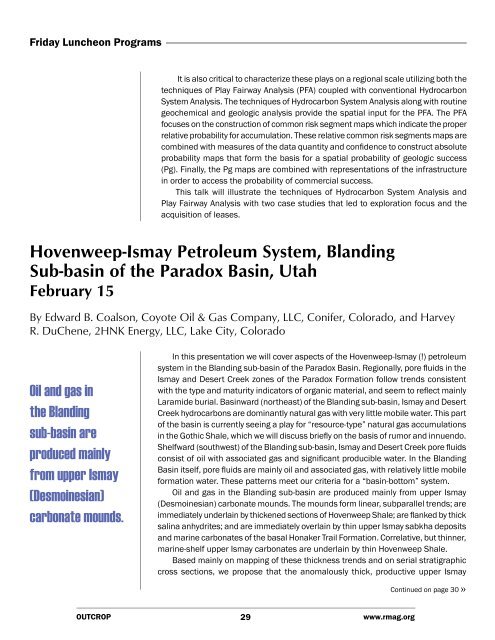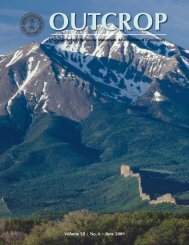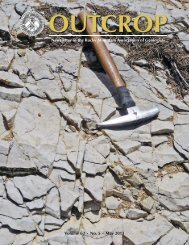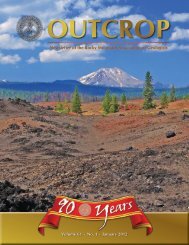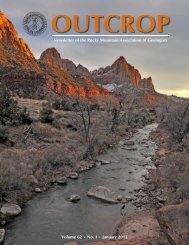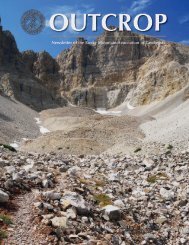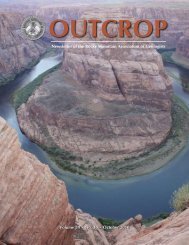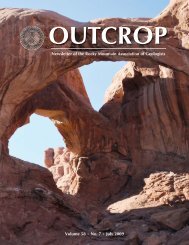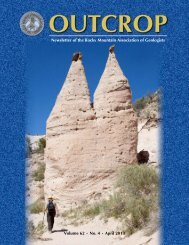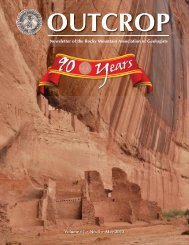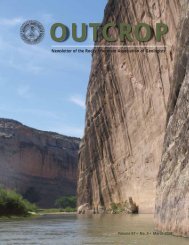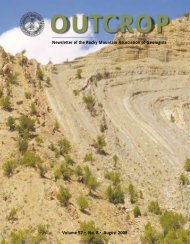February 2008 - Rocky Mountain Association of Geologists
February 2008 - Rocky Mountain Association of Geologists
February 2008 - Rocky Mountain Association of Geologists
You also want an ePaper? Increase the reach of your titles
YUMPU automatically turns print PDFs into web optimized ePapers that Google loves.
Friday Luncheon Programs<br />
It is also critical to characterize these plays on a regional scale utilizing both the<br />
techniques <strong>of</strong> Play Fairway Analysis (PFA) coupled with conventional Hydrocarbon<br />
System Analysis. The techniques <strong>of</strong> Hydrocarbon System Analysis along with routine<br />
geochemical and geologic analysis provide the spatial input for the PFA. The PFA<br />
focuses on the construction <strong>of</strong> common risk segment maps which indicate the proper<br />
relative probability for accumulation. These relative common risk segments maps are<br />
combined with measures <strong>of</strong> the data quantity and confidence to construct absolute<br />
probability maps that form the basis for a spatial probability <strong>of</strong> geologic success<br />
(Pg). Finally, the Pg maps are combined with representations <strong>of</strong> the infrastructure<br />
in order to access the probability <strong>of</strong> commercial success.<br />
This talk will illustrate the techniques <strong>of</strong> Hydrocarbon System Analysis and<br />
Play Fairway Analysis with two case studies that led to exploration focus and the<br />
acquisition <strong>of</strong> leases.<br />
Hovenweep-Ismay Petroleum System, Blanding<br />
Sub-basin <strong>of</strong> the Paradox Basin, Utah<br />
<strong>February</strong> 15<br />
By Edward B. Coalson, Coyote Oil & Gas Company, LLC, Conifer, Colorado, and Harvey<br />
R. DuChene, 2HNK Energy, LLC, Lake City, Colorado<br />
Oil and gas in<br />
the Blanding<br />
sub-basin are<br />
produced mainly<br />
from upper Ismay<br />
(Desmoinesian)<br />
carbonate mounds.<br />
In this presentation we will cover aspects <strong>of</strong> the Hovenweep-Ismay (!) petroleum<br />
system in the Blanding sub-basin <strong>of</strong> the Paradox Basin. Regionally, pore fluids in the<br />
Ismay and Desert Creek zones <strong>of</strong> the Paradox Formation follow trends consistent<br />
with the type and maturity indicators <strong>of</strong> organic material, and seem to reflect mainly<br />
Laramide burial. Basinward (northeast) <strong>of</strong> the Blanding sub-basin, Ismay and Desert<br />
Creek hydrocarbons are dominantly natural gas with very little mobile water. This part<br />
<strong>of</strong> the basin is currently seeing a play for “resource-type” natural gas accumulations<br />
in the Gothic Shale, which we will discuss briefly on the basis <strong>of</strong> rumor and innuendo.<br />
Shelfward (southwest) <strong>of</strong> the Blanding sub-basin, Ismay and Desert Creek pore fluids<br />
consist <strong>of</strong> oil with associated gas and significant producible water. In the Blanding<br />
Basin itself, pore fluids are mainly oil and associated gas, with relatively little mobile<br />
formation water. These patterns meet our criteria for a “basin-bottom” system.<br />
Oil and gas in the Blanding sub-basin are produced mainly from upper Ismay<br />
(Desmoinesian) carbonate mounds. The mounds form linear, subparallel trends; are<br />
immediately underlain by thickened sections <strong>of</strong> Hovenweep Shale; are flanked by thick<br />
salina anhydrites; and are immediately overlain by thin upper Ismay sabkha deposits<br />
and marine carbonates <strong>of</strong> the basal Honaker Trail Formation. Correlative, but thinner,<br />
marine-shelf upper Ismay carbonates are underlain by thin Hovenweep Shale.<br />
Based mainly on mapping <strong>of</strong> these thickness trends and on serial stratigraphic<br />
cross sections, we propose that the anomalously thick, productive upper Ismay<br />
Continued on page 30 »<br />
OUTCROP<br />
29<br />
www.rmag.org


